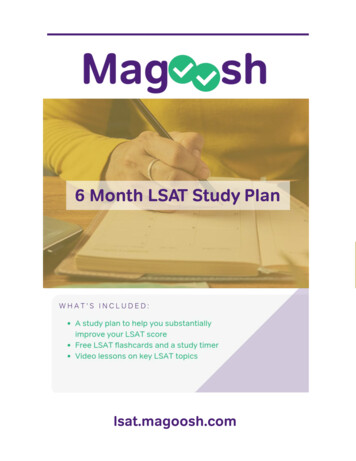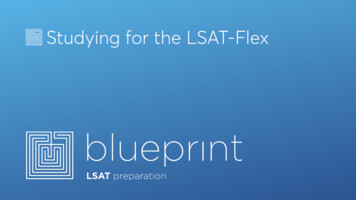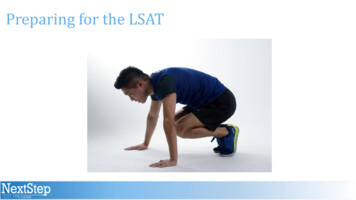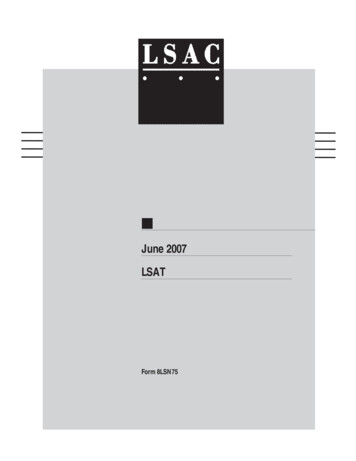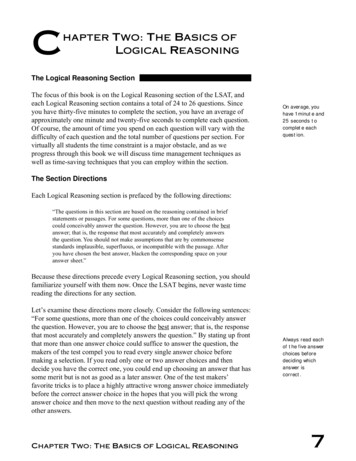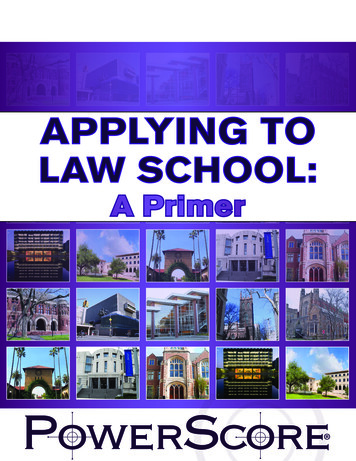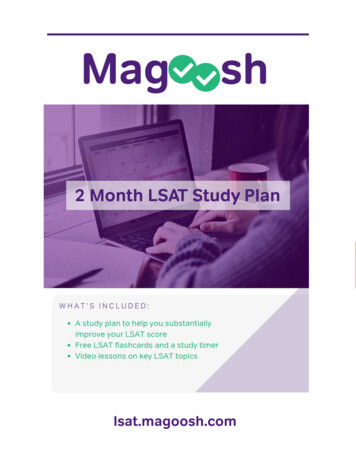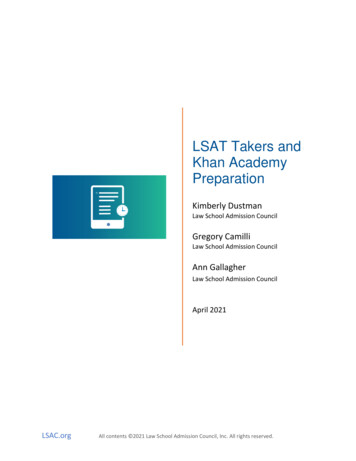
Transcription
LSAT Takers andKhan AcademyPreparationKimberly DustmanLaw School Admission CouncilGregory CamilliLaw School Admission CouncilAnn GallagherLaw School Admission CouncilApril 2021LSAC.orgAll contents 2021 Law School Admission Council, Inc. All rights reserved.
Law School Admission CouncilLSAT Takers and Khan Academy PreparationAbstractFree online Law School Admission Test (LSAT) preparation resources from theLaw School Admission Council and Khan Academy have been widely utilized by LSATand LSAT-Flex test takers. In September 2020, nearly 70,000 individuals engaged withKhan Academy’s Official LSAT Prep platform. The purpose of this study was toexamine the potential effects of engagement on actual LSAT performance. Ouranalyses showed that a higher level of engagement (measured in terms of practice timeand number of practice exams taken) was associated with higher performance on theLSAT. These results held not only for the overall population but also across multipledemographic subgroups. The results also showed that the performance of test takerswith lower initial practice exam scores was associated with slightly higher LSAT scoregains per practice minute, indicating that these students benefitted at least as much asstudents who scored higher initially. Because this was a quasi-experimental controlledstudy, the possibility of alternative influences on LSAT performance cannot be ruled out.However, we believe that engagement with the Khan Academy platform is currently thebest explanation for the LSAT score increases observed in this study.IntroductionFree online Law School Admission Test (LSAT) preparation resources from theLaw School Admission Council (LSAC) and Khan Academy have been widely utilized byLSAT and LSAT-Flex test takers. In September 2020, nearly 70,000 individuals spenttime on Khan Academy’s Official LSAT Prep platform. Thousands of official practicequestions from real tests are available, and learners can create a personalized practiceplan tailored to their strengths and weaknesses. Interactive lessons, problem sets,timed practice exams, and videos engage learners in making real progress toward theirgoals. The Khan platform (Figure 1) is designed to build confidence in the learningprocess for prospective test takers while teaching the fundamental reasoning skills thatare central to both legal education and academic work.LSAC.orgAll contents 2021 Law School Admission Council, Inc. All rights reserved.1
Law School Admission CouncilFIGURE 1. Khan Academy’s Official LSAT Prep platformOne purpose of this preliminary study was to examine usage of the KhanAcademy test-prep platform and to test the hypothesis that such usage has a positiveeffect on LSAT performance. However, we caution that the research design is not a trueexperiment in which individuals are randomly assigned to treatment and controlconditions (Shadish et al., 2002)—though a number of potentially confounding variableswere controlled through regression analysis. While we believe Khan usage is the bestexplanation for our findings, the possibility of alternative explanations cannot be ruledout (Grosz et al., 2020). A second purpose of this study is to determine whether theassociation between level of Khan usage and LSAT performance differed across racial,ethnic, and gender subgroups.LSAC.orgAll contents 2021 Law School Admission Council, Inc. All rights reserved.2
Law School Admission CouncilLiterature ReviewResearch in the field of test preparation shows that while students generallyengage in some form of test-prep study, they often have unequal access to costly testprep services. Powers (1998) surveyed a random sample of students registered to takethe SAT to determine whether the availability and use of a variety of SAT-prepprograms provided access and learning opportunities to students without adequatefamily resources or income. Results of the survey indicated that some methods of testprep were more frequently cited than others, including taking the PSAT (PreliminarySAT) and utilizing test-prep materials provided by the College Board, whereas other,more resource-intensive methods were used less often and were likely beyond themeans of average test takers. Examples of such methods include private tutoring,services provided by commercial test-prep companies, and programs sponsored by aschool or other organization outside of school. Students in the study self-reported anaverage of approximately 11 hours preparing for the SAT. Students in the sample whoattended coaching or tutoring sessions outside of school paid an average of 400 forthese services. According to a recent LSAC report, Sweeney et al. (2019) found that themost popular self-indicated methods of preparation for the LSAT in 2017–2018 (prior tothe availability of Khan Academy’s Official LSAT Prep) were self-study, official LSACprep materials, and commercially available non-LSAC books or software.Researchers have cautioned that self-selection can distort the perceivedeffectiveness of a program: Students who engage in test preparation may differsystematically from students who do not in terms of characteristics such as motivationor degree of financial support. Study designs must control for these differences beforeattributing score gains to test preparation (Powers, 1993). Powers and Camara (1999)found that coached SAT takers differed from noncoached SAT takers in terms ofsocioeconomic status, race, and ethnicity. Similarly, Buchmann et al. (2010) found thatfamily financial capital influenced the likelihood that test takers will engage in test prep.While massive open online courses (MOOCs) and independent learning contentsites are becoming increasingly popular, there has been little research studying theireffectiveness in terms of student learning outcomes. Despite a high dropout rate forsome MOOCs (Hew & Cheung, 2014), e-learning reaches a wide variety of learners andis quickly being incorporated into the educational landscape (Abdulaziz, 2018). Gardnerand Brooks (2018) explored how learners’ online course data could be used to createpredictive models of student success, but they also noted methodological gaps in muchLSAC.orgAll contents 2021 Law School Admission Council, Inc. All rights reserved.3
Law School Admission Councilof this research, such as the lack of experimental design. Other research investigatespsychological considerations in how MOOCs are designed and used to aid studentinstruction (Terras & Ramsay, 2015) as well as how to best maintain motivation andengagement (Sun et al., 2019). Given the prevalence of online courses and e-learningmaterials, research is needed to understand their impact on student learners.SampleWithin 2 days after every test administration, LSAC emails students who havetaken the most recent administration of the LSAT, inviting them to complete the PostLSAT Questionnaire (PLQ). One PLQ question asks LSAT takers to indicate whetherthey used Khan Academy to prepare for the test. Those who indicate in the affirmativeare given the option to have their data used for research purposes. For any given testadministration, about 65–75% of Khan users consent to sharing their data with LSACresearchers; in this report, they are identified as the Consenting Khan Users subgroup.Data for Consenting Khan Users from June 2018 (Khan Academy’s Official LSATPrep launch date) through July 2020 were matched with Khan Academy usageinformation, resulting in a sample of 12,471 records. Of these test takers, 61% took theLSAT once, 27% took the LSAT twice, 8% took the LSAT three times, and 3% took itfour or more times.To determine the representativeness of the sample, we compared theConsenting Khan Users subgroup (n 12,471) to (a) the All Self-Reported Khan Userssubgroup (i.e., all 2018–2019 test takers who indicated that they had used Khan toprepare for the LSAT; n 38,572 test takers) and (b) the All Test Takers group (i.e., all2018–2019 test takers; n 100,183).Table 1 displays distributions of test takers across the various demographicsubgroups; some differences across samples are evident (see also Table A-1 in theAppendix). Those in the Consenting Khan Users subgroup were more likely to identifyas Black, white, and female compared to those in the All Self-Reported Khan Userssubgroup and the All Test Takers group. They were also more likely to be Pell Grantrecipients, and more likely than those in the All Test Takers group to be first-generationcollege graduates.1 Those in the Consenting Khan Users subgroup were also less likelyto be first-generation college graduates compared to those in the All Self-Reported1“First generation” was defined as individuals whose parents did not receive a bachelor’s degree.LSAC.orgAll contents 2021 Law School Admission Council, Inc. All rights reserved.4
Law School Admission CouncilKhan Users subgroup. Because of these differences, we used proportionalpoststratification weighting2 so that the Consenting Khan Users subgroup betterreflected the All Self-Reported Khan Users subgroup in terms of gender, race, andethnicity.TABLE 1. Demographic breakdown of Khan sample, Khan users, and all test takersGroup% American IndianConsentingKhan Users(June 2018-July 2020) aAll Khan Users(June 2018-May 2019) bAll Test Takers(June 2018-May 2019)c0.290.390.36% Asian71011% Black151311889% White545351% Two or moreraces/ethnicities1099% Female645957% Male364143% Pell Grantrecipient372725% First generation354530Average age26252515115115112,47138,572100,183% HispanicAverage LSAT scoreSample sizea Khanusers who consented to sharing their data with LSAC researchers for LSAT exams taken between June 2018and July 2020.b LSAT test takers who indicated they used Khan Academy when asked at time of taking LSAT for LSAT examstaken during the 2018-2019 testing year.c All individuals who took the LSAT during the 2018-2019 testing year.Across subgroups based on race and ethnicity, nearly half of test takers indicatedthat they used Khan Academy to prepare for the LSAT. As shown in Figure 1, Black testtakers were the most likely demographic subgroup to have used Khan Academy as partof their LSAT preparation.2See adjusting for nonresponse by weighting: ation.LSAC.orgAll contents 2021 Law School Admission Council, Inc. All rights reserved.5
Law School Admission CouncilFIGURE 1. Percentage of test takers who self-reported using Khan Academy byrace and ethnicity (n 5,177) 3,460%50%54%47%47%43%38%40%30%20%10%0%Native AmericanAsianBlackWhiteHispanicDescriptive StatisticsAnalyses of Khan usage indicated that approximately 8% of the sample set apractice schedule; of those, the average practice goal was 8.6 hours per week. Usagewas primarily measured through the following variables calculated over the timeintervals prior to each time an individual took the LSAT: practice minutes, videominutes, and number of unique practice exams taken.5 For example, for Khan userswho took the LSAT for the first time, usage was calculated over the interval from thelaunch of Khan Academy’s Official LSAT Prep platform (June 2018) to the date of theirLSAT exam. For students who took the LSAT a second time, Khan usage was restrictedto the time interval between their first and second exam dates. The average number ofweeks spent engaging with the platform (defined as having positive minutes active in3Native American includes individuals of Native Alaskan descent. See LSAC report Understanding andInterpreting Law School Enrollment Data: A Focus on Race and Ethnicity for more information on raceand ethnicity categories: focus-race-and.4Results are reported for the February 2020 administration, as this was the last time Khan usage datawas collected on test day.5 Practice minutes are defined as time spent on Khan Academy’s Official LSAT Prep practice tasks andincludes both time spent on discrete skill practice tasks and time spent on practice exams/diagnostics.Video minutes are defined as time spent watching Khan Academy’s LSAT instructional videos. At the timeof this analysis, ten unique full-length LSAT practice exams were available through the Khan Academyplatform.LSAC.orgAll contents 2021 Law School Admission Council, Inc. All rights reserved.6
Law School Admission Councilthe week) was 8 weeks. The average total time that Khan users spent on the platformprior to taking an LSAT was 24.5 hours: 18.3 hours were spent on practice tasks and1.8 hours on instructional videos (Table 2).TABLE 2: Engagement statistics by total sample and across UGPA subgroupsTotalSampleUGPA 3.32UGPA3.32–3.75UGPA 7.87.97.37.712,4713,3993,4394,373Engagement StatisticGoal practice hours/weekNumber of weeks using KhanTotal hours spent on KhanVideo hoursPractice hoursNumber of unique practice exams takenPractice LSAT score gainSample sizeAbout 51% of Khan users did not complete an LSAT practice exam. Of thosewho did, a little under half (47%) completed 1–3 practice exams, 44% completed 4–9practice exams, and 9% completed all 10 available practice exams. The averageLSAC.orgAll contents 2021 Law School Admission Council, Inc. All rights reserved.7
Law School Admission Councilnumber of unique practice exams completed was 4.5 exams, and the average gainbetween the first practice LSAT score and the most recent practice LSAT score wasabout 3 points. While some variation in usage statistics was observed acrossdemographic subgroups, differences were generally small and not statisticallysignificant. Descriptive statistics are also reported across undergraduate GPA (UGPA)subgroups. Those with a higher UGPA tended to use Khan more than those with alower UGPA. Prior research has shown that a higher GPA may be reflective of strongerstudy habits, increased motivation, and study enjoyment (Alshawwa et al., 2015).Accordingly, persistence may be a mediating factor influencing academic success.Two primary usage variables were used to measure engagement in ouranalyses: (a) minutes spent on practice activities6 and (b) number of unique practiceexams taken, binned into six categories (0, 1–2, 3–4, 5–6, 7–8, and 9–10; see Table 7).Other usage variables were examined but were found not to correlate with actual LSATscores. Video minutes, for example, were not correlated with LSAT scores, but theywere positively associated with age (r 0.16, p .0001), meaning that older test takerswere somewhat more likely to spend time viewing videos.Because the relationship between the number of practice exams and LSATscores was not assumed to be linear, our subsequent regression analysis examined thepotential boost for practice exams binned into five categories (1–2, 3–4, 5–6, 7–8, and9–10) relative to having taken no practice exams. Taking more practice exams generallyresulted in increased LSAT scores relative to number of practice exams taken(unbinned; see box plots in Figure 2).6Because the raw distribution of minutes spent on practice activities was right-skewed with high-endoutliers, we used a log transformation to normalize the distribution.LSAC.orgAll contents 2021 Law School Admission Council, Inc. All rights reserved.8
Law School Admission CouncilFIGURE 2. LSAT score by number of unique practice exams completedAs shown in Table 3, Pearson correlations of UGPA with LSAT score werepositive (r .33). However, practice minutes showed a stronger relationship with LSATscore than with UGPA (.19 versus .08, respectively). This suggests that students’practice minutes are not entirely determined by their prior achievement, as measured byUGPA; rather, students across a variety of achievement levels are engaging with Khanpractice activities.TABLE 3: Pearson’s correlations among LSAT score, UGPA,and practice minutesVariableLSAT ScoreUGPAUGPA0.33*—Practice minutes0.19*0.08**p .0001LSAC.orgAll contents 2021 Law School Admission Council, Inc. All rights reserved.9
Law School Admission CouncilMethodsA series of least-squares linear regressions were used to model the effects ofKhan usage while controlling for UGPA, Pell Grant status (a proxy for socioeconomicstatus), and test-taker age. Regressions were performed separately to test the effect ofeach of two engagement variables on LSAT score: log practice minutes (LPM) andnumber of unique practice exams completed. These two engagement variables weremodeled separately. Both were considered to have value for describing the potentialeffects of Khan Academy LSAT preparation; however, it was determined that includingboth variables in the model simultaneously would create multicollinearity problems.Regressions were conducted on the total sample as well as within race, ethnicity, andgender subgroups—demographic classifications particularly important to LSAC forunderstanding diversity issues.ResultsTable 4 presents regression results for the effect of LPMs on LSAT score. Aseparate regression was also performed that restricted the sample to individuals whohad LPMs of at least 2 (corresponding to approximately 6 minutes of practice time).Both regressions controlled for UGPA, Pell Grant status (binary: 1 or 0), and age. Thisregression model is depicted in the following equation using Y LSAT score as thedependent variable:LSAC.orgAll contents 2021 Law School Admission Council, Inc. All rights reserved.10
Law School Admission CouncilRegression 1wherea Model interceptb1 Slope for log practice minutes (X1)b2 Slope for UGPA on 4.0 scale (X2)b3 Slope for Pell Grant status (X3)b4 Slope for test-taker age (X4)Ε ResidualTABLE 4: Regression statistics by total sample and by subgroup withLPM 2Regression StatisticTotal Sample LPMLPM 2Standardized slope β.17 a.18 a.21.216,9386,550R2Sample sizeaUnstandardized regression coefficient significant at p 0.01.As shown in Table 4, the standardized regression slope was designatedgenerically as β, and it has a scale similar to that of correlation coefficients. Thestandardized slopes can be interpreted as moderate, but positive and statisticallysignificant, suggesting a positive effect on LSAT scores with more time spent on KhanAcademy’s Official LSAT Prep practice activities.7 Little difference was observedbetween the regression results for the full sample and the regression results for thesample that was restricted to participants spending at least 7 practice minutes on theKhan platform. Similar results were also observed when analyses were repeated acrossracial, ethnic, and gender subgroups.Table 5 provides a practical guide for interpreting the results of the regression forthe total sample, showing the increase in LSAT score corresponding to practice time. Tofacilitate interpretation, all comparisons below are made relative to the 10th percentile ofpractice time (26 minutes). Accordingly, students at the 90th percentile of practice time7A standardized regression coefficient of 0.17 indicates that—holding UGPA, Pell Grant status, and testtaker age constant—every increase of 1 standard deviation in LPM on average results in a 0.17 increasein the standard deviation of LSAT score.LSAC.orgAll contents 2021 Law School Admission Council, Inc. All rights reserved.11
Law School Admission Council(47 hours) had scores that, on average, were 4.3 points higher than students at the 10thpercentile. Analyses of racial, ethnic, and gender subgroups showed similar increases,with all subgroups having standardized regression coefficients within 0.05 points of oneanother. These subgroup breakdowns can be found in Tables A-2 and A-3 in theAppendix. Note that the results reported in Table 5 are not gains for students who tookthe LSAT twice but rather increments for independent groups of students who spentdifferent amounts of practice time on Khan.TABLE 5. Average LSAT scores for practice time percentiles aPercentileTimeIncreaseEffect Size b10th26 mBaseline—25th (Q1)3h1.70.1650th (Q2)11 h2.90.2775th (Q3)27 h3.80.3590th47 h4.30.40aLSAT score gains from increased practice time compared to baseline 10th percentile. Practice timein minutes (m) and hours (h). Times over one hour rounded to nearest whole hour.b To compute effect sizes, each score increase was divided by the sample standard deviation for theLSAT, 10.7.We also considered whether the effect of LPM on LSAT scores might differ forstudents starting at different baselines, which we defined as the score on their firstpractice exam (FPE). To examine this potential association, a set of interactionvariables were developed in two steps. First, a set of dummy variables was obtained forFPE score quartiles (FPE1–FPE4) and then mean centered (CFPE1–CFPE4); LPM wasalso mean centered (CLPM). Second, a set of interaction indicators was obtained:INT2 CFPE2*CLPM, INT3 CFPE3*CLPM, and INT4 CFPE4*CLPM, whereomitting INT1 (and CFPE1) results in the first quartile being designated as the referencecategory. These interaction effects were then estimated controlling for UGPA, Pell Grantstatus, and age for test takers with LPM 0 and who took at least one practice exam,as depicted in the regression model below using Y LSAT score as the dependentvariable:LSAC.orgAll contents 2021 Law School Admission Council, Inc. All rights reserved.12
Law School Admission CouncilRegression 2where the regression coefficients (a, b) are defined above in Regression 1 andc2 – c4 Slopes for FPE2 – FPE4d2 – d4 Slopes for INT2 – INT4As shown in Table 6, we observed larger standardized effects of LPM forindividuals in the second and third FPE quartiles (.24) than for those in the fourth FPEquartile (.18). While individuals with lower FPE scores tend to score lower on the actualLSAT than those with higher FPE scores, these interactions also suggest that lowerscoring individuals have a higher rate of return for practice minutes, whereas higherscoring students have less room to improve due to a potential ceiling effect.TABLE 6. Regression statistics for modelincluding interactions between LPM and FPEcategoryPredictorStandardized .18R2.64Sample size4,607Note. All regression slopes .18 were significant atp .01.We also found that the number of practice exams completed was associated withincreased LSAT score increments, both overall and across various demographicsubgroups. For the number of practice exams taken, we created a set of six dummycategorical variable bins BPE1–BPE6 corresponding to six bins (0, 1–2, 3–4, 5–6, 7–8,and 9–10). Sample sizes for these bins varied across subgroups, as shown in Table 7.LSAC.orgAll contents 2021 Law School Admission Council, Inc. All rights reserved.13
Law School Admission CouncilTABLE 7. Sample size breakdown for race, ethnicity, and gender subgroups by binsindicating number of practice exams takenBinned Practice TestCategory ple0 Count4062891,1181596391,2871,9550 Column percent36.53526.83327.830.929.81-2 Count282187995935459631,5301-2 Column percent25.422.623.819.323.723.123.43-4 Count172129713803387261,0793-4 Column percent15.515.617.116.614.717.416.55-6 Count9895531462864847815-6 Column percent8.811.512.79.512.511.611.97-8 Count8861360541973555567-8 Column percent7.97.48.611.28.68.58.59-10 Count6665458502913506499-10 Column 964,1656,550Sample sizeThe following regression model was then applied to each demographic subgroupseparately using the LSAT score (labeled Y) as the dependent variable:Regression 3wherea Model interceptb1 Slope for UGPA (X1)b2 Slope for Pell Grant status (X2)b3 Slope for test taker age (X3)c2 – c6 Slopes for BPE2 – BPE6Ε ResidualBoth the raw and the standardized coefficients are given in Table 8, where eachcolumn shows results from a separate regression for each demographic subgroup. Thecoefficients c2–c6 can be interpreted as the average point increase in LSAT score forbins 2–6, respectively, relative to having taken no practice exams (referred to here asthe zero-exam reference group), controlling for UGPA, Pell Grant status, and age (thisLSAC.orgAll contents 2021 Law School Admission Council, Inc. All rights reserved.14
Law School Admission Councilinterpretation follows from omitting BPE1 from the regression model). For practicalpurposes, the magnitudes of standardized regression slopes can be interpreted along ascale from 1 to 1. For example, Black Khan users who took 1–2 practice examsscored 2.84 points higher, on average, compared to Black Khan users who took nopractice exams, while Black Khan users who took 9–10 practice exams scored, onaverage, about 8 points higher than Black Khan users who took no practice exams.Note that the coefficients are all expressed in terms of a comparison to the samedemographic subgroup of Khan users who took no practice exams but who spent atleast 6 minutes of practice time on Khan. Regressions include UGPA, Pell Grant Status,and test-taker age. The final two rows show the R-square and adjusted R-square valuesfor separate regression models that only include the covariates UGPA, Pell Grantstatus, and age for anyone in the sample who took a complete practice exam. Resultsfor Native American test takers are not reported due to the small sample size but will bereported in future research after more Khan usage data are available.TABLE 8. Regression statistics for racial, ethnic, and gender subgroups, using binnednumber of practice exams to predict LSAT scoresaBinned Practice ExamRegression -2 Slope2.84*2.46*.95** 1.39.751.76*1.59*.13.11.04 .70*7.61*7.26*9-10 β.21.20.22.14.18.20.21R2.21.21.17.23.18.29.23Adj 80.140.150.110.180.140.230.181-2 βb3-4 Slope3-4 β5-6 Slope5-6 β7-8 Slope7-8 β9-10 SlopeR2 cAdjR2 cMaleaEach exam group comparison is made to the zero-exam reference group. Regressions are restricted to individualswho spent 2 log practice minutes (about 6 minutes).b Standardized regression coefficient.c Separate regression includes only the covariates UGPA, Pell Grant status, and test-taker age.*p 0.01, ** p 0.05.LSAC.orgAll contents 2021 Law School Admission Council, Inc. All rights reserved.15
Law School Admission CouncilIn an effort to rule out alternative explanations for the influence that the numberof practice exams may have on LSAT scores, we examined whether individuals whotook more practice exams were also more likely to take a commercial LSAT prepcourse. If this were the case, the effects of Khan and commercial test prep would beconfounded. Looking at the entire Khan sample, 31% reported having taken acommercial test-prep course. Table 9 displays the percentages for the subset whocompleted practice exams; those who completed more practice exams were not morelikely to have also taken a commercial test-prep course. This indicates that it is unlikelythat the boost associated with using Khan can alternatively be attributed to commercialtest prep.TABLE 9. Commercial test-prep usage for Khan users whocompleted at least one practice exam on the Khan platformBinned Practice 8302229–1031273Several analyses were also conducted to examine regression assumptions. First,despite the presence of a few moderately large residuals, regression coefficients wererobust with respect to removal of these outliers. Second, comparative residual analysiswas conducted, and it was determined that LSAT performance was predicted aboutequally well across most demographic subgroups.DiscussionOur analyses showed that greater usage of LSAT test prep on Khan Academywas associated with higher performance on the LSAT. This finding holds true fordemographic subgroups as well as for the overall population. Increased time spent onKhan Academy’s Official LSAT Prep platform was associated with higher LSAT scores,and increases in both practice time and number of completed practice exams wereassociated with significantly higher LSAT performance. Our research also showed thatthe performance of test takers with lower initial practice exam scores was associatedwith slightly higher LSAT score gains per practice minute, indicating that students whomight have otherwise scored lower on the LSAT may have benefitted the most frompractice activities, a finding that could indicate that Khan has the potential to decreaseLSAC.orgAll contents 2021 Law School Admission Council, Inc. All rights reserved.16
Law School Admission Councilthe score gap among demographic groups. Additionally, the association between agreater number of completed practice exams and higher LSAT scores was mostpronounced among test takers who identified as Black, Hispanic, and female.Because the Khan LSAT platform is free of charge and easily accessible online,individuals preparing to take the LSAT may want to consider incorporating KhanAcademy’s Official LSAT Prep activities when preparing for the LSAT. In fact, oursample of Khan users were less likely to indicate that they had taken a commercial testprep course than were test takers generally (31% of our sample versus 43% of testtakers who responded to the Post-LSAT Questionnaire), suggesting that many studentsare using Khan Academy as their core preparation, not simply as supplemental practice.Khan Academy LSAT preparation is likely a prag
Free online Law School Admission Test (LSAT) preparation resources from the Law School Admission Council and Khan Academy have been widely utilized by LSAT and LSAT-Flex test takers. In September 2020, nearly 70,000 individuals engaged with . Khan Academy’s . Official LSAT

